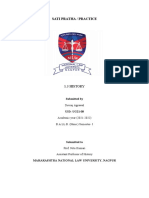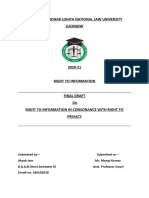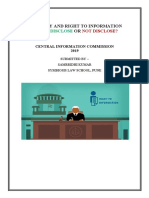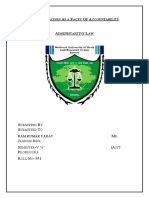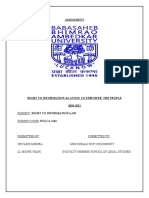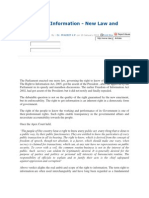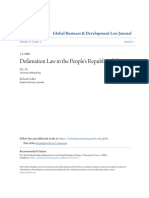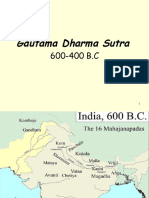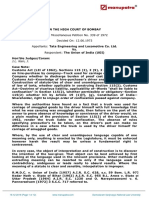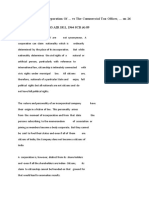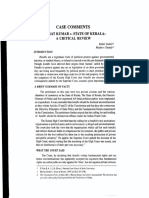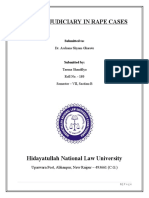Sting Operations: The Role of Media As A Vigilante: Ahkam Khan & Parimal Kashyap
Sting Operations: The Role of Media As A Vigilante: Ahkam Khan & Parimal Kashyap
Uploaded by
Simran GahuniaCopyright:
Available Formats
Sting Operations: The Role of Media As A Vigilante: Ahkam Khan & Parimal Kashyap
Sting Operations: The Role of Media As A Vigilante: Ahkam Khan & Parimal Kashyap
Uploaded by
Simran GahuniaOriginal Title
Copyright
Available Formats
Share this document
Did you find this document useful?
Is this content inappropriate?
Copyright:
Available Formats
Sting Operations: The Role of Media As A Vigilante: Ahkam Khan & Parimal Kashyap
Sting Operations: The Role of Media As A Vigilante: Ahkam Khan & Parimal Kashyap
Uploaded by
Simran GahuniaCopyright:
Available Formats
STING OPERATIONS: THE ROLE OF MEDIA AS A VIGILANTE
Ahkam Khan & Parimal Kashyap*
INTRODUCTION
A sting operation is an investigative exercise undertaken by media to uncover the
malpractices prevalent in the society. It is an inseparable part of the modern news casting,
albeit with questionable moral issues included.1 These undercover operations embark to
disentangle the administrative procedures by an agent who pretends to be a part of the game–
by acting like a supplicant, a vulnerable candidate, a support-searcher or a potential bribe
supplier.2Masterminding somebody under the lawful drinking age to request that a grown-up
purchase an alcoholic beverage for them or conveying a snare auto (likewise called a honey
trap) to get a car thief and recording them on tape are certain examples. 3 Another example
might be a journalist pretending to be an interested party looking to get his work done in a
government office by bribing the officials.
Sting operations are full of inquiries of legitimacy, and objectivity that are hard to manage in
light of the fact that the journalist is a common person loaded with his predispositions for or
against somebody or something. Therefore, the rightfulness of a sting operation cannot be
determined objectively as the journalist may have a bias towards or against a certain person
that he might target. In addition, in the present world where video doctoring tools are easily
accessible and widely used, the question of legitimacy of the sting operation audio/video is
yet another issue for thought.
The word 'Sting Operation' was first used in the movie ‘Sting’ in 1973 which depended on a
plot incubated by two men to trap a third individual into carrying out a wrongdoing. 4 The
expression 'Sting' is also illustrative of media's power in a democratic set-up and how it can
be both potent and venomous for the public at large; potent by exposing the evils, and
* The Authors are currently 3rd year B.A. LL.B. (Hons.) students at Dr. Ram Manohar Lohiya National Law
University, Lucknow.
1
Roshan John, Legality of Sting operations, LAW WIRE www.lawinfowire.com/articleinfo/legality-sting-
operations, last visited 11 June 2017.
2
Roy Greenslade, Journalism: To Sting or not to sting?, THE GUARDIAN, (June 2, 2013)
https://www.theguardian.com/media/2013/jun/02/sleaze-journalist-sting-debate.
3
SPECIAL REPORT: Local Police Crackdown on Adults Buying Booze for Minors, K.E.S.Q., (May 18, 2004),
https://web.archive.org/web/20090115202841/www.kesq.com/Global/story.asp?S=1878103&nav=9qrxNETb.
4
Sherman v. United States, 356 U.S. 369 (1958).
61
Published in Articles section of www.manupatra.com
venomous by infringing the fundamental right to privacy of an individual or potentially
entrapping someone into accepting a bribe and thereby, causing corruption.5
A few nations like US, UK and Canada have perceived sting operations completed by legal
enforcement agencies as lawful techniques for gathering evidence.6 However, there are no
directions regarding the test for legality of sting operations in India and there is no nexus in
decisions given by various courts, which requires an earnest need to address the issue.
Sting Operations: Positive or Negative
Despite the fact that the freedom of press is not ensured in our constitution unequivocally, a
few interpretations by the apex Court have held it as a basic part of our constitution.7
However, this freedom is not absolute and there are some sensible limitations.8 In the
technological age, the electronic media has assumed control over the print media, and a huge
number of individuals have access to and can be strongly influenced by the information
published by media.
Media has an incredible role to play as the fourth pillar of democracy.9 This is based on a
simple equivalence relationship i.e. corruption cannot breed within the sight of transparency.
The role of media involves uncovering callous and degenerate public servants to the eye of
the omnipotent public in a democratic set-up and hence, undoubtedly, media is in its
legitimate space while utilizing apparatuses of investigative journalism to make people
familiar with the hideous underbelly of the society.10 However, occasionally, media, in its
endeavors to secure efficient administration, over-reaches its assigned obligation of
disseminating information and clashes with the judicial functions of law enforcement.
On the premise of purpose, there can be a delegation of string operations as positive or
negative. The positive are the ones in light of a legitimate concern for the overall population
and planned to penetrate the cover of the government’s working procedure. 11 The negative
ones don't profit the general public, but are a sensationalized endeavor to build the viewership
5
Pramod Nair, A Sting in the Tale, (2014) 49(22) E.P.W.
6
Sorrells v. United States, 287 U.S. 435 (1932) 441, 451.
7
Indian Express v. Union of India, A.I.R. 1986 S.C. 515; Romesh Thapar v. Union of India, A.I.R. 1950 S.C.
124.
8
The Constitution of India, art 19(2) (1950).
9
Sakal Papers Ltd v. Union of India, A.I.R. 1962 S.C. 305.
10
Court on its own motion v. State,(2008) 146 D.L.T. 429.
11
Ethics of Media Sting Operations, I.A.S. G.S., (April 5, 2017), www.iasgs.com/2017/04/ethics-of-media-sting-
operations.
62
Published in Articles section of www.manupatra.com
in the era of 'breaking news' by encroaching the privacy or sanctity of an individual or a
body.12
The Judicial Perspective vis-à-vis Sting Operations in India
In India, it was ‘Tehelka’ that foreshadowed the act of sting operations and increased its
following, prominence, and circulation to gigantic levels through these operations.13 The
sting recordings of March 2001 demonstrated a few defense authorities, and government
officials from the ruling party accepting bribes, which resulted in immediate administrative
action that led to their ousting.14
India neither has a particular law administering the lawfulness of sting operations nor a
judicial pronouncement laying down the guidelines for the regulation of sting operations.
Besides the Cable TV Regulation Act15, which lays down the guidelines for the channels
airing programmes, the Pre-natal Diagnostic Techniques Act is the sole authority that talks
about sting operations and maintains the legitimacy of the same for the purpose of the Act.
The Courts have decided every matter so far on the actualities of the case.
There are no hard and fast rules to determine the different conditions under which the sting
operation will be a legal method of obtaining evidence or a method against law. The Courts,
while dealing with different situation have not been able to come to a consensus and there is
no nexus between the decisions of various courts on similar situations pertaining to sting
operations. The Courts on several occasion have held Sting operations to be a legal method of
obtaining evidence16, while on some occasions have held them to be an inducement to
crime17 or an invasion of the fundamental right to privacy18.
· Sting Operations as:
A. Legal Action
12
Id.
13
Luke Harding, Website Pays Price for Indian Bribery Expose, THE GUARDIAN, (January 6, 2003),
www.theguardian.com/technology/2003/jan/06/newmedia.india.
14
Celia Dugger, The Sting that has India Writhing, N.Y. TIMES,(March 16, 2001),
www.nytimes.com/2001/03/16/world/the-sting-that-has-india-writhing.html.
15
Cable Television Networks (Regulation) Act (1995).
16
Raja Ram Pal v. Hon’ble Speaker, LokSabha (2007) 3 S.C.C. 184; R.K. Anand v. High Court of Delhi, (2009)
8 S.C.C. 106.
17
Rajat Prasad v. C.B.I., (2014) 6 S.C.C. 495.
18
Labour Liberation Front v. State of A.P., (2005) 1 A.L.T. 740.
63
Published in Articles section of www.manupatra.com
The role of sting operations in deliverance of justice in India cannot be undermined. Media,
as the fourth pillar of democracy, has a great role to play in a transparent democratic society
driven by certain people with power elected by the public itself or chosen through open
public service examinations. These officials get the much necessary autonomy in their work.
However, complete detachment from the public interest, and furtherance of individual
interest through their discretionary powers or actions behind closed doors, warrant regular
check-up.
In SP Gupta v Union of India19, “No democratic Government can survive without
accountability and the basic postulate of accountability is that people should have the
information about the working of the Government.” The public entrusts the media with the
task of acting as a regulatory mechanism for these power-holders. Though the Indian
constitution does not expressly guarantee the freedom of press as a fundamental right, various
interpretations of the apex court under Article 19(1) (a) have enshrined it as a basic
constituent of right to freedom of speech and expression.20 The media, therefore, has a right
to impart and disseminate information in public interest in correspondence to the public’s
right to know about the public acts performed by the public officials and the sting operations,
aim at, nothing more than public interest.21
In various cases, the media made a special effort in public interest to get the haughty crooks
penalized for their blameworthy activities.22 “I thank god and the media for helping me out in
this long battle”, these words of the victim’s mother, in Nitish Katara23 murder case indicate
the role played by the sting operations.24
In the disputable cash-for-queries swindle, the Delhi High Court endorsed the legality of the
sting operations directed to uncover the misconduct of the Parliamentarians that led to the
ousting of 11 members from their term in the office.25 The single judge bench of the Delhi
High Court opined that such a privilege spilled out of the fundamental duty to treasure the
19
A.I.R. 1982 S.C. 149.
20
Bennett Coleman v. Union of India, A.I.R. 1973 S.C. 106; Sakal Papers v. Union of India [1962] 3 S.C.R.
842.
21
State of U.P. v. Raj Narain, A.I.R. 1975 S.C. 865.
22
Manu Sharma v. State, (2010) 6 S.C.C. 1; Sanjeev Nanda v. State, (2007) Cri.L.J. 3786.
23
Vikas Yadav v. State of U.P. (2016) 9 S.C.C. 541.
24
Nitish Katara case: SC upholds conviction of Vikas Yadav, Vishal Yadav, THE INDIAN EXPRESS, (October
3, 2016), http://indianexpress.com/article/cities/delhi/nitish-katara-murder-case-sc-upholds-conviction-of-vikas-
vishal-yadav/.
25
Raja Ram Pal v. Hon’ble Speaker,Lok Sabha (2007) 3 SCC 184.
64
Published in Articles section of www.manupatra.com
noble ideals that inspired our struggle for freedom as under Article 51A (b) 26, and making a
pure and autonomous India is one such ideal.27
The apex court in RK Anand28 deferentially removed itself from meddling with the autonomy
of media by dismissing the request to set down rules for sting operations stating that this
would be a transgression of the media's privilege of the freedom of expression ensured under
Article 19(1) of the Constitution. Therefore, the call for accepting sting operations as a legal
method of obtaining evidence is merely an extension of the right to freedom of press as
ensured through judicial activism in India. Therefore, obliteration of the concept of liberty of
press through a proscription on sting operations by media due to isolated incidents of misuse
of the power vested in the media is not a way out.
I. Entrapment or Inducement to Crime
A sting operation has genuine legal ramifications. In the event that it uncovers the defilement
of a public servant, the columnist in charge of it wins ubiquity. If not, it leaves him
vulnerable to criminal accusations.29
When a particular journalist goes undercover and plays to be a part of the scheme of things
while trying to uncover the corruption in a particular department, he is simply resting on the
allegations on and image of the public officials working in that department. Even if they were
not involved in corruption before, this might be their first encounter with a person trying to
bribe them and with such a lucrative offering at hand, they might accept the bribe; which will
lead the media to the conclusion that the ghosts of corruption already haunted such
department, even if they did not. You cannot hold a person guilty for a crime that he would
not have committed, had he not been encouraged to do so.
A sting operation aired by ‘Live India’, demonstrated Ms. Uma Khurana, a teacher,
purportedly compelling a young student into prostitution.30 In the mayhem that took after, a
few people physically assaulted her and even tore her clothes. The Court took suomotu
cognizance of the matter and started proceedings where the Court discovered that the accused
26
The Constitution of India, Art 51 (1950).
27
Aniruddha Bahal v. State, (2010) 172 D.L.T. 269.
28
R.K. Anand v. High Court of Delhi, (2009) 8 S.C.C. 106.
29
Madhubhushi Sridhar, A Sting Without Public Interest is a Crime, THE HOOT, (July 30, 2014),
http://www.thehoot.org/media-watch/law-and-policy/a-sting-without-public-interest-is-a-crime-7672.
30
Fake Sting: Uma Khurana Withdraws Defamation Case, THE TIMES OF INDIA (October 22, 2008),
http://timesofindia.indiatimes.com/city/delhi/Fake-sting-Uma-Khurana-withdraws-defamation-
case/articleshow/3629666.cms.
65
Published in Articles section of www.manupatra.com
was innocent and a piece of the sting operation had been arranged dramatically. 31 The court,
relying on the decision in Keith Jacobson v. United States32, held that media in its endeavors
to reveal truth in public interest ought not to go too far by turning to entanglement of any
individual.33 The US Supreme Court had held that “in their zeal to enforce law, law
protectors must not originate a criminal design, and then induce commission of the crime so
that the government may prosecute.”34
The Supreme Court in Rajat Prasad v. C.B.I.35 held the journalist, who conducted the sting
operation, guilty of abetment to bribery by stating that where a man draws another to
acknowledge a payoff while covertly video recording the demonstration, it is ensnarement,
which could be legitimate or criminal, relying upon the goal and thought process of the bribe
supplier.
If the allegations are baseless, the sting operations might as well serve as entrapment for the
honest public officials. The question is one of public morality i.e., firstly, you induce a person
into committing a crime by promising him a reward for breaking the law and then hold him
guilty for accepting the bait. Scholars have suggested, every now and then, that the public
officials are subject to wider scrutiny of the media in general interest and, therefore, there
should be no entrapment charges on media for sting operations conducted against them. The
term ‘public servant’ finds its definition in the Prevention of Corruption Act.36 However, one
more aspect that requires contemplation is whether a sting operation is permissible when the
public servant is not acting during the course of his duty; bringing in, the question of invasion
of an individual’s privacy.
II. An Invasion of Privacy
Despite the fact that the right to privacy had not been specifically revered in the Indian
Constitution, the development of Right to Life under article 2137 has given a sanctuary to
Right to Privacy through different points of reference set by various case laws which have
ceaselessly expressed it as an imperative element for a cheerful life.38
31
Supra note 10.
32
503 U.S. 540 (1992).
33
Supra note 10.
34
Supra note 32.
35
(2014) 6 S.C.C. 495.
36
Prevention of Corruption Act, § 2(c) (1988).
37
Constitution of India, art 21 (1950).
38
Kharak Singh v. State of U.P., A.I.R. 1963 S.C. 1295; Govind v. State of M.P., A.I.R. 1975 S.C. 1378.
66
Published in Articles section of www.manupatra.com
Furthermore, a nine-judge bench of the Supreme Court, in a recent judgment, pointed out that
privacy is an essential element of life and personal liberty and is a part of the fundamental
right guaranteed under Article 21 of the Constitution in its spirit.39 The autonomy of an
individual’s existence should not be meddled with; neither by state nor by any other entity.
Sting operations in public interest, have been acknowledged as a lawful technique to uncover
wrongdoings on various events. However, one of the essential motivations to carry out these
operations is to expand the TRP evaluations or to 'intrigue the general population' as opposed
to 'public interest'.
There have been quite a few instances where media has encroached upon the right to privacy
of an individual exposing his private life to the scrutiny of general public. The production of
what a Mumbai newspaper asserted were photos of Kareena Kapoor and ShahidKapur
sharing intimate moments, the revelation of Shakti Kapoor's casting couch controversy, and
the video of Swami Paramahamsa in a compromising position with a Tamil actress, that
ended her career, have all collectively added to the outcry for a more characterized right to
privacy in the nation.40
Grave mishandling of innovative progress and the unhealthy rivalry in the field of news
coverage has brought about the pulverization of the standard sense of duty expected in the
noble profession.41 Wiretapping or telephone tapping, a part of sting operations, was held to
be a gross violation of privacy, and as such regulated, both under a legislation 42 and
guidelines laid down in a judicial pronouncement43.
The right to express freely, which is the backbone of media, has been subject to abuse and the
question of privacy in contrast to expression remains unanswered, with no legislation to
regulate and balance the two rights.
REPERCUSSIONS OF STING OPERATIONS ON FAIR TRIAL
The role of media has been in question, every now and then, in relation to running media
trials before the actual hearing of a case in the court of law. Media trials become more
influencing, particularly, when they happen because of a sting operation. The broadcast of
sting operations happens in such a manner that a prejudice is set in the minds of the public.
39
K.S. Puttuswamy v. Union of India, 2017 S.C.C. OnLine 996.
40
Shoma Chatterjee, Sting Operations and the Ethics of Journalism, KERALA MEDIA ACADEMY,
<http://mediamagazine.in/content/sting-operations-and-ethics-journalism.
41
Labour Liberation Front v. State of A.P., (2005) 1 A.L.T. 740.
42
The Telegraph Act (1885).
43
P.U.C.L. v. Union of India, A.I.R. 1997 S.C. 568.
67
Published in Articles section of www.manupatra.com
The video object produced by stings circulates all around and influences a variety of
environments, including judiciary. As soon as a sting operation takes place, media transforms
itself into a public court. As per the Indian Criminal Law, a person is innocent until his guilt
is proven in the court of law. Media trials completely ignore this ideal notion and the person
against whom the sting operation is conducted is exhibited as the convict. Running a parallel
trial also adds pressure on lawyers; who end up not taking such cases.
Trial run by media does not only add prejudice against the accused but also does severe
damage to the person’s reputation, even after his acquittal. A classic example of this would
be Uma Khurana’s case44 where the court found that the sting operation was false. Though
the accused was acquitted but the media trial following the sting, resulted in her termination
and she was assaulted by the protesting mob.45 This case demonstrates how sting operations
can victimize an innocent and cause damage to one’s reputation.
Delhi High Court, in a recent case, has made an observation stating, “Media trials do tend to
influence judges. Subconsciously a pressure is created and it does have an effect on the
sentencing of the accused/convict”.46 Various courts and law commissions all around the
world have seconded this view.47 The Supreme Court too, in various cases, has observed that
the media publication of a sub-judice trial tends to induce the judges subconsciously.48 There
has also been an instance where the Apex Court passed an order restraining media from
publishing about the pending trial of a civil case in order to prevent any prejudice.49
The concept of fair trial becomes enormously crucial in case of criminal law because it deals
with community at large. Apex Court in has categorically explained the concept of fair trial.
The court in this case held, “It has to be unmistakably understood that a trial which is
primarily aimed at ascertaining the truth has to be fair to all concerned. It will not be correct
to say that it is only the accused who must be fairly dealt with. Each one has an inbuilt right
44
I.L.R. (2008) 2 Delhi 44.
45
Fake sting: Uma Khurana withdraws defamation case, THE TIMES OF INDIA,
http://timesofindia.indiatimes.com/city/delhi/Fake-sting-Uma-Khurana-withdraws-defamation-
case/articleshow/3629666.cms, last visited September 25, 2017.
46
Media Trials Tend to Influence Judges: Delhi HC on India's Daughter Documentary, FIRST POST, (March
12, 2015), www.firstpost.com/india/media-trials-tend-influence-judges-delhi-hc-indias-daughter-documentary-
2149773.html.
47
200th Law Commission Report on Media Trial, 51-57.
48
P.C. Sen (In Re), A.I.R. 1970 S.C. 1821.
49
Reliance Petrochemicals Ltd. v. Proprietors of Indian Express, (1988) 4 S.C.C. 592.
68
Published in Articles section of www.manupatra.com
to be dealt with fairly in a criminal trial. Fair trial means a trial in which bias or prejudice
for or against the accused, the witnesses, or the cause which is being tried is eliminated.”50
The Constitution of India guarantees the right to a free and fair trial. 51 When media
broadcasts sting operations, the prejudice against the accused violates his right to fair trial.
This fundamental right comes in clash with Right to Freedom of Speech and Expression,
which is also a fundamental right.52 In such cases, it becomes the duty of the courts to
develop progressive measures so that both the rights get appropriate space in the
constitutional system.
It is the media’s responsibility, which executes such trials. A journalist should not approach
the affair in the question with an attitude of a prosecutor. While dealing with matters that are
sub-judice, the media should have a fair, broad-minded, and balanced attitude.53
THE QUESTION OF ADMISSIBILITY OF EVIDENCE OBTAINED THROUGH STING OPERATIONS
The debate on admissibility of evidences obtained through acts like sting operations is largely
political than solely evidential.54 It is said that, “It matters not how you get it; if you steal it
even, it would be admissible in evidence”.55 Common law seems to be following this
principle while examining admissibility of evidence obtained through illegal means.
Evidence stays to be admissible even in cases of agent provocateurs56 and invasion of
privacy.57
However, it is regularly contended that the evidence procured by a sting has been gotten by
actuation and consequently, inadmissible. Nonetheless, others trust that when evidence is
convincing, it ought to be permissible; and little heed should be paid on the methods through
which it was secured. Some argue that sting operations should only be allowed and be
admissible in a proceeding if media has received prior approval for the conducting the same.
However, such a setup will render media as some kind of vigilance agency for the courts.
50
Zahira Habibullah Sheikh v. State Of Gujarat, (2006) 3 S.C.C. 374.
51
The Constitution of India, art 21 (1950).
52
The Constitution of India, art 19(1) (1950).
53
Press Council of India, Norms of a Journalist Conduct, PRESS COUNCIL OF
INDIA,http://presscouncil.nic.in/OldWebsite/NORMS-2010.pdf (last visited September 28, 2017).
54
David Anthony Brooke, Confessions. Illegally/ Improperly Obtained Evidence and Entrapment Under the
Police and Criminal Evidence Act 1984: Changing Judicial and Public Attitudes to The Police and Criminal
Investigations, Thesis submitted for the Degree of Ph. D. University College, London 1999.
55
R. v. Leatham, (1861) 8 Cox C.C. 498.
56
R. v. Sang, [1980] A.C. 402, H.L.
57
R. v. Khan (Sultan), [1997] A.C. 558, H.L.
69
Published in Articles section of www.manupatra.com
This would not only be equivalent to pre-censorship of broadcasting of court procedures but
also curtail media’s right to freedom of speech and expression warranted under Article 19(1)
of Indian Constitution.58
The status remains to be foggy, as courts have also given clashing elucidations. As per the
general guideline, evidence is overlooked when it is secured by charming the charged into
executing a wrongdoing.59 Nonetheless, Indian courts have disregarded the above stated
principle having in mind the larger public interest.60 Evidence collected by a sting operation
is an extra-judicial statement given to a third party in specific circumstance, which makes it
admissible.61 Truth be told, the announcements made through sting operations are more
convincing than other additional legal explanations since they are recorded, which makes
them practically verifiable.62 However, the Apex Court has taken a contradictory view by
holding that tape-recorded statements represent inducement and are therefore, inadmissible.63
Consequently, there is an absence of well-defined law and courts’ interpretation becomes the
final law.
It is suggested that in cases where evidences are supposedly procured by illegal means, courts
should only exercise discretionary powers when such illegality has influenced reliability of
the evidence, thereby, affecting fairness of the trial.64 While securing the uprightness of the
criminal justice system is certainly a rationale for not admitting the evidence obtained
through sting operations, the courts have held in numerous judgments that this discretionary
power should not be used to discipline the procurer. Further, courts are not supposed to
balance the reliability of such evidence with their onus of protecting the right to a fair trial.65
Sting operations are a tool that aids in dispensing justice. Although, under the shade of
journalism, this tool could be used for personal and political benefits but that should not
prevent courts from reaping the benefits it offers. The courts have a responsibility of ensuring
the fairness of proceedings, and it will not be possible if the court does not hear all relevant
58
R.K. Anand v. National Capital Territory of Delhi, 2009 S.C.C. OnLine C.A.T. 1818
59
R. v. Sang,(1979) 2 All E.R. 1222.
60
Sri Bhardwaj Media Pvt. Ltd.av. State, W.P. (Crl.) Nos. 1125 and 126/2007.
61
Piara Singh v. State of Punjab, (1977) 4 S.C.C. 459; Barindra Kumar Ghose v. Emperor, I.L.R (1910) 37 Cal.
467.
62
Indian Evidence Act, § 24 (1872).
63
State of Haryana v. Ved Prakash,1994 Cr.L.J. 140 (SC).
64
Adrian Keane, James Griffiths & Paul McKeown, The Modern Law of Evidence 52 (8th edn., Oxford
University Press 2010).
65
Id.
70
Published in Articles section of www.manupatra.com
evidence which either sides puts forward.66 Thus, while examining the admissibility of sting
operation as an evidence, the court should look if the sting operation has an intention of
greater public good or not. This demands balance with the defendant’s right to a free and fair
trial. There cannot be a rigid law on the admissibility of evidence procured through sting
operation because if one approach hinders justice dispensation mechanism, the other could
violate one’s right to free and fair trial. Therefore, the courts should follow a middle path
while providing their valuable interpretations. Moreover, while interpreting the facts of a
case, the courts ought to take into consideration the seriousness of the crime committed. This
would depend on facts of a case and would vary from case to case.
CONCLUSION
Sting Operations have been an incredible instrument in uncovering wrongdoing and
defilement in the public arena. We have seen various situations where sting operations have
assumed a noteworthy part in securing justice for all. Be that as it may, a line is required to be
drawn between sting operations that assault privacy and those which reveal debasement and
like others with a particular objective to secure the very soul of the Constitution of India. In
any case, in the present circumstances where political corruption is at its apex, it is difficult to
essentially discover which sting operations are politically invigorated, which are truly
proposed to filter the social order, or which are truly the results of fabricated broadcast
bolstered by different political gatherings, their corporate benefactors.
A set of accepted rules and effective regulation is required. It is henceforth recommended that
a sovereign quasi-judicial organization should be established that has forces of both censure
and execution. It is also suggested that a law should be enacted to avoid media from
meddling into the privacy of individuals. A set of guidelines67 relating to broadcasting of
sting operations have been provided. Since, there is no immunity provided by law, journalists
ought to adhere to the guidelines to prevent any liability.
Since, there is no law that deals with admissibility of evidence procured by a sting operations,
courts need to give less recognition to Factum of Entrapment and alluring the suspect into
conferring an offense when weighed against admissibility of evidences. More accentuation
ought to be laid on the way the crime has been committed which would have been committed
anyway even if inducement was not there.
66
R. v. Quinn, [1990] Crim. L.R. 581, C.A.
67
Supra note 53.
71
Published in Articles section of www.manupatra.com
Sting operations are every now and again guarded on the ground that the media has a
commitment to put the unscrupulous criminals in the sight of people when the law-
enforcement agencies are unwilling to do so. However, without a strong arrangement of
standards and regulations, these operations can similarly change into a race to build greater
viewership ratings.
72
Published in Articles section of www.manupatra.com
You might also like
- Sati Pratha / Practice: 1.3 HistoryDocument15 pagesSati Pratha / Practice: 1.3 Historydevraj agrawalNo ratings yet
- Right To Privacy Vis A Vis MediaDocument7 pagesRight To Privacy Vis A Vis MediaratikaattriNo ratings yet
- Assignment 2 - ATIDocument6 pagesAssignment 2 - ATILoni Apple WelchNo ratings yet
- Sting Operation - To Be or Not To Be in IndiaDocument8 pagesSting Operation - To Be or Not To Be in IndiaTanzil GanamNo ratings yet
- DefamationDocument3 pagesDefamationAadarsh JoshiNo ratings yet
- Dr. Ram Manohar Lohiya National Law University LucknowDocument20 pagesDr. Ram Manohar Lohiya National Law University LucknowAkash JainNo ratings yet
- Aditoriyama Civil SocietyDocument19 pagesAditoriyama Civil SocietyAditya Pratap SinghNo ratings yet
- Judiciary and Right To Information (Ms. Samrridhi Kumar) PDFDocument37 pagesJudiciary and Right To Information (Ms. Samrridhi Kumar) PDFShubham KhandelwalNo ratings yet
- 0020 Deswal Full Text 0 v1Document6 pages0020 Deswal Full Text 0 v1LEKHA DHILIP KUMARNo ratings yet
- RTI Act PDFDocument35 pagesRTI Act PDFfunnyrokstarNo ratings yet
- Internship Research Paper - Vratika PhogatDocument19 pagesInternship Research Paper - Vratika PhogatNayan SinghNo ratings yet
- Admin LawDocument9 pagesAdmin LawRam Kumar YadavNo ratings yet
- Internship Research Paper - Vratika PhogatDocument19 pagesInternship Research Paper - Vratika Phogatinderpreet sumanNo ratings yet
- R T I A F o ADocument9 pagesR T I A F o ARam Kumar Yadav100% (1)
- (21-27) Role of Right To Information Act 2005 in The Human DevelopmentDocument7 pages(21-27) Role of Right To Information Act 2005 in The Human DevelopmentiisteNo ratings yet
- Rti & DemocracyDocument20 pagesRti & DemocracyjaishreeNo ratings yet
- Critical Analysis of Working of RTI in IndiaDocument39 pagesCritical Analysis of Working of RTI in Indiaelitepm90% (10)
- Assign RtiDocument15 pagesAssign RtiurviNo ratings yet
- Justice Murphy, in Conway v. Johan, 331 US 367 1. Sec 2 Contempt of Courts Act 1971Document6 pagesJustice Murphy, in Conway v. Johan, 331 US 367 1. Sec 2 Contempt of Courts Act 1971UriahNo ratings yet
- Right To Privacy Vis-À-Vis Rti: Balancing Rights & Managing Conflicts Gaurav & RoopDocument14 pagesRight To Privacy Vis-À-Vis Rti: Balancing Rights & Managing Conflicts Gaurav & RoopGaurav HoodaNo ratings yet
- The Right To InformationDocument7 pagesThe Right To InformationMd. Akmal HossainNo ratings yet
- Sting Operations & Right To Pivacy July 2022Document20 pagesSting Operations & Right To Pivacy July 2022Nirani GroupNo ratings yet
- Research Paper CicDocument21 pagesResearch Paper CicVaibhav MittalNo ratings yet
- An Analysis of The Section - 8 (1) (D), (G), (I) of The RTI ActDocument19 pagesAn Analysis of The Section - 8 (1) (D), (G), (I) of The RTI Actbackupsanthosh21 dataNo ratings yet
- 3 RD CIVICEDUSSS1Document11 pages3 RD CIVICEDUSSS1ekongjoseph5No ratings yet
- Anand Doctrinal On Right To Information ActDocument25 pagesAnand Doctrinal On Right To Information ActStanis Michael50% (2)
- Right To Information AssignmentDocument3 pagesRight To Information AssignmentPrincy SharmaNo ratings yet
- The Importance of Privacy Law TodayDocument12 pagesThe Importance of Privacy Law TodayMiss ManishaNo ratings yet
- Unit 15Document24 pagesUnit 15mrsaritrahassanNo ratings yet
- Critical Analysis of Working of RTI in IndiaDocument43 pagesCritical Analysis of Working of RTI in IndiavineetNo ratings yet
- Rule of Law in Singapore: Independence of The Judiciary and The Legal Profession in SingaporeDocument21 pagesRule of Law in Singapore: Independence of The Judiciary and The Legal Profession in SingaporeJacob George50% (2)
- Session 3 - RTIDocument9 pagesSession 3 - RTI589 TYBMS Shivam JoshiNo ratings yet
- ESSAYDocument13 pagesESSAYtessiesechele01No ratings yet
- Right To Privacy V RTIDocument35 pagesRight To Privacy V RTIChristy Alex100% (1)
- Media and Law ProjectDocument11 pagesMedia and Law ProjectTulika GuptaNo ratings yet
- Rti DemocracyDocument20 pagesRti DemocracyShivam MalikNo ratings yet
- Written SubmissionsDocument14 pagesWritten SubmissionsRadhika GoelNo ratings yet
- A Commentary On RA 10175Document26 pagesA Commentary On RA 10175master_rolandoNo ratings yet
- Unit 6Document25 pagesUnit 6Anushka YaduwanshiNo ratings yet
- Admin ProjectDocument10 pagesAdmin ProjectanshitaNo ratings yet
- The Right To Information Act in Bangladesh: An Analysis in The Light of Johannesburg Principles of Freedom of Information LegislationDocument18 pagesThe Right To Information Act in Bangladesh: An Analysis in The Light of Johannesburg Principles of Freedom of Information LegislationAmit DeyNo ratings yet
- Media Law Final DraftDocument10 pagesMedia Law Final DraftDeepak RavNo ratings yet
- Role of The Media in A DemocracyDocument6 pagesRole of The Media in A DemocracyVineet MehtaNo ratings yet
- Ishikaa Banot 221082 PAPPDocument13 pagesIshikaa Banot 221082 PAPPIshikaa BanotNo ratings yet
- CPL FinalDocument21 pagesCPL FinalAkshay ShekhawatNo ratings yet
- Dr. Ram Manohar Lohiya National Law University, Lucknow: Admissibility of Evidence Gathered Through Sting OperationDocument16 pagesDr. Ram Manohar Lohiya National Law University, Lucknow: Admissibility of Evidence Gathered Through Sting OperationPranav BhansaliNo ratings yet
- Right To Information Act and Good GovernanceDocument26 pagesRight To Information Act and Good GovernanceSanjay Ram DiwakarNo ratings yet
- 1597628133-Right-To-Information AmendmentDocument6 pages1597628133-Right-To-Information AmendmentAshkar ChandraNo ratings yet
- Cyber Monday: View Deals NowDocument11 pagesCyber Monday: View Deals NowvenugopalNo ratings yet
- Introduction To Right To InformationDocument10 pagesIntroduction To Right To InformationAprajitaNo ratings yet
- Right To InformationDocument77 pagesRight To InformationRaj Kumar ChakrabortyNo ratings yet
- The Shari 'A Approach To Contemporary Problems of Mass SurveillanceDocument44 pagesThe Shari 'A Approach To Contemporary Problems of Mass Surveillancescribd.g0nutNo ratings yet
- Meaning of Information Under IT ActDocument8 pagesMeaning of Information Under IT ActABINASH NRUSINGHANo ratings yet
- RTI Final EditDocument49 pagesRTI Final EditRaj PatelNo ratings yet
- A Need For Emendation of Sedition Laws in IndiaDocument14 pagesA Need For Emendation of Sedition Laws in IndiaDIPESH RANJAN DASNo ratings yet
- Civil Society ProjectDocument14 pagesCivil Society Projectayush singhNo ratings yet
- Defamation Law in The Peoples Republic of ChinaDocument23 pagesDefamation Law in The Peoples Republic of ChinaRusty ShacklefordNo ratings yet
- The Alert Citizen - Analyzing the Issues Within the Patriot ActFrom EverandThe Alert Citizen - Analyzing the Issues Within the Patriot ActNo ratings yet
- Hell No: Your Right to Dissent in Twenty-First-Century AmericaFrom EverandHell No: Your Right to Dissent in Twenty-First-Century AmericaRating: 3 out of 5 stars3/5 (1)
- Advent of Islam Into IndiaDocument38 pagesAdvent of Islam Into IndiaSimran GahuniaNo ratings yet
- GautamaDocument34 pagesGautamaSimran GahuniaNo ratings yet
- Mughal AdministrationDocument35 pagesMughal AdministrationSimran GahuniaNo ratings yet
- Press Council of India: A Toothless TigerDocument6 pagesPress Council of India: A Toothless TigerSimran GahuniaNo ratings yet
- PUDR v. Police Comissioner, (1989) 4 SCC 730Document3 pagesPUDR v. Police Comissioner, (1989) 4 SCC 730Simran GahuniaNo ratings yet
- Tata Engineering and Locomotive Co LTD Vs The UnioM730165COM171700Document12 pagesTata Engineering and Locomotive Co LTD Vs The UnioM730165COM171700Simran GahuniaNo ratings yet
- Consti 1Document15 pagesConsti 1Simran GahuniaNo ratings yet
- Family Ii ProjectDocument1 pageFamily Ii ProjectSimran GahuniaNo ratings yet
- Section 111 of Transfer of Property Act Section 111-: MANU/SC/0005/1991Document10 pagesSection 111 of Transfer of Property Act Section 111-: MANU/SC/0005/1991Simran GahuniaNo ratings yet
- Damodaram Sanjivayya National Law University Visakhapatnam, A. P., IndiaDocument20 pagesDamodaram Sanjivayya National Law University Visakhapatnam, A. P., IndiaSimran GahuniaNo ratings yet
- Swot EcoDocument8 pagesSwot EcoSimran GahuniaNo ratings yet
- Torts ProjectDocument20 pagesTorts ProjectSimran GahuniaNo ratings yet
- Socio IiDocument21 pagesSocio IiSimran GahuniaNo ratings yet
- The State Trading Corporation ofDocument2 pagesThe State Trading Corporation ofSimran Gahunia100% (1)
- Citizenship ActDocument13 pagesCitizenship ActSimran GahuniaNo ratings yet
- Format. Hum - The Right To Privacy Is Protected As An Intrinsic Part of The Right To Life and Personal Liberty Under Article 21 of The Constitution of India An EvaluationDocument12 pagesFormat. Hum - The Right To Privacy Is Protected As An Intrinsic Part of The Right To Life and Personal Liberty Under Article 21 of The Constitution of India An EvaluationImpact JournalsNo ratings yet
- Judges in Contemporary DemocracyDocument333 pagesJudges in Contemporary DemocracyFernando DannerNo ratings yet
- Salient Features of Indian Constitution.: Abhipedia EpfoDocument23 pagesSalient Features of Indian Constitution.: Abhipedia EpfoSwapnil TripathiNo ratings yet
- Bharat Kumar Vs State of KerelaDocument3 pagesBharat Kumar Vs State of KerelaAnchit JassalNo ratings yet
- Rights of Arrested Person CRPCDocument35 pagesRights of Arrested Person CRPCAmudha Mony91% (11)
- Counter Claim - Order 8 Rule 6A To 6G.: FactsDocument2 pagesCounter Claim - Order 8 Rule 6A To 6G.: FactsAnusha V RNo ratings yet
- Moot Court Memorial (MR Alex v. Union of Scandina)Document19 pagesMoot Court Memorial (MR Alex v. Union of Scandina)debjitkrmaji6No ratings yet
- Privacy and Data Protection in IndiaDocument13 pagesPrivacy and Data Protection in IndiaAditi YadavNo ratings yet
- National Law Institute University Bhopal: Law of Jurisprudence Semester VIIDocument13 pagesNational Law Institute University Bhopal: Law of Jurisprudence Semester VIISiddhant BarmateNo ratings yet
- Inter-Country AdoptionDocument3 pagesInter-Country AdoptionDharmendra RaiNo ratings yet
- IN THE COURT OF (District and Court Name)Document27 pagesIN THE COURT OF (District and Court Name)Aryan PriyadarshiNo ratings yet
- Indian Polity 365 MCQ Study InsightDocument221 pagesIndian Polity 365 MCQ Study Insightluitsarmah1234No ratings yet
- Good GovernaceDocument50 pagesGood Governacedouble dragonNo ratings yet
- Sem7 CRPC TanuDocument18 pagesSem7 CRPC TanuTaruna ShandilyaNo ratings yet
- Contribution of Indian Judiciary in The Development of Environmental JurisprudenceDocument19 pagesContribution of Indian Judiciary in The Development of Environmental JurisprudenceDevendra DhruwNo ratings yet
- Anguilla Constitution Draft 2009Document74 pagesAnguilla Constitution Draft 2009Marie HenryNo ratings yet
- Hussainara Khatoon vs. State of Bihar, Kajal PatilDocument11 pagesHussainara Khatoon vs. State of Bihar, Kajal PatilkajalpatilNo ratings yet
- Memorial On Behalf of The Respondent by Nameera MerajDocument18 pagesMemorial On Behalf of The Respondent by Nameera Merajnameera merajNo ratings yet
- Chapter 1: The Indian ConstitutionDocument3 pagesChapter 1: The Indian ConstitutionnancyNo ratings yet
- What's Law Got To Do With Justice - Agenda - 26Document64 pagesWhat's Law Got To Do With Justice - Agenda - 26Disability Rights AllianceNo ratings yet
- 3585 2019 15 1501 39507 Judgement 03-Nov-2022Document48 pages3585 2019 15 1501 39507 Judgement 03-Nov-2022Ancy DeepakNo ratings yet
- Sexual HarrashmentDocument17 pagesSexual HarrashmentvinayakNo ratings yet
- A Critical Study On Social Justice in IndiaDocument24 pagesA Critical Study On Social Justice in IndiaAnshu Sharma100% (1)
- Worksheet No.5.Class IX. Democratic Rights 2023-24Document2 pagesWorksheet No.5.Class IX. Democratic Rights 2023-24yamini.takwaleNo ratings yet
- Freedom of Press in India1Document13 pagesFreedom of Press in India1Swetank SrivastavaNo ratings yet
- Salient Features of The Constitution of 1956Document12 pagesSalient Features of The Constitution of 1956WAQASJERALNo ratings yet
- Consititution of India: Project Report ON Article - 12Document18 pagesConsititution of India: Project Report ON Article - 12Apne DipuNo ratings yet
- Writ PetitionDocument43 pagesWrit PetitionfredrickNo ratings yet
- PT Sprint 2023 Polity and Governance @upsc - Success - Time1Document155 pagesPT Sprint 2023 Polity and Governance @upsc - Success - Time1Nitin SinghNo ratings yet
